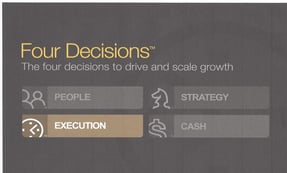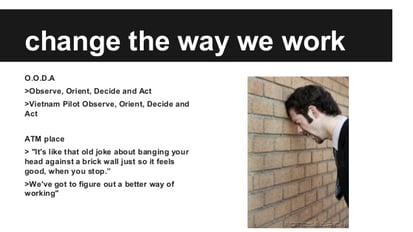In the movie “Saving Private Ryan,” the scene from Omaha Beach reinforces General Dwight D. Eisenhower’s quote, “Plans are Worthless, Planning is Everything.”
Whatever plans the US Marines had when they landed suddenly vanished as the German onslaught hit them. The chaos of the situation is addressed by the private in the scene who asks, “What the hell do we do now sir?”
In this and the next several blogs we’re sharing the extensive value and knowledge of Scrum: The Art of Doing Twice the Work in Half the Time by Jeff Sutherland.  Decisions equal success: Execution
Decisions equal success: Execution
If you’re asking what does Omaha Beach and Scrum have to do with the Rockefeller Habits and Scaling Up? Decisions equal success. There are four decisions, in growing your business, you must get right or risk leaving significant revenues, profits, and time on the table. These Four Decisions are: People Strategy, Execution and Cash.
 The result of getting each Decision right is:
The result of getting each Decision right is:
- People: Culture of Accountability
- Strategy: Top line revenue Growth
- Execution: Profit
- Cash: Oxygen and Options
Scrum’s specific focus is execution. A company can triple revenue, capitalizing on a differential advantage, only to see their profitability drop due to sloppy execution. Another indicator of poor execution is the number of hours spent delivering your products or services. When execution is haphazard, the organization relies on the “heroics” of their people putting in long hours just to keep the wheels from falling off the organization. Tighten your execution habits. You can dramatically improve gross margins and profitability while reducing the time it takes for everyone to complete their work. Scrum achieves dramatic results in productivity. It’s why Sutherland was a speaker at the Dallas Growth Summit last year!
What Eisenhower and his marines discovered on the beach is exactly what Sutherland learned in his tour of duty as a pilot in Vietnam. Scrum follows an “Inspect and Adapt” cycle. Periodically while working on a project, stop doing what you’re doing, review what you’ve done, and see if it’s still what you should be doing and how you might do it better. It’s a simple idea, but executing it requires thought, introspection, honesty, and discipline.
Sutherland learned the concept of “Inspect and Adapt” in a life-or-death situation in Vietnam. For American fighter pilots in Vietnam, a tour of duty meant flying one hundred missions into enemy territory. Fifty percent of the pilots got shot down. Most died. Others were imprisoned. A few were rescued.
Sutherland describes missions this way, “The moment I crossed over the border into North Vietnam, my Heads-Up display would light up like a pinball machine, and the loud missile-warning system would go off with a flurry of beeps and whistles. The sky would brighten with tracer fire from antiaircraft guns, and I knew that, in minutes, missile radar would soon be pinpointing my aircraft unless 500 feet was low enough to stay in the ground clutter. During these moments my adrenaline would pump, but I never lost my cool. Instead, the danger almost settled me. I credit this to the training I got from the Air Force on how to control risk.”
That training taught Sutherland to do four things: Observe, Orient, Decide, and Act. Observe the target area, figure out the best path into the hot zone and the best path out, orient in the face of unexpected events, and then act decisively based on instincts and hardwiring. Hesitation could get pilots killed, but so did foolhardiness.
Cancer Research
When Sutherland returned from the Vietnam war, he earned a Master’s degree from Stanford in statistics. He spent as much time as possible at the Stanford Artificial Intelligence Laboratory. Upon graduation Sutherland became a professor of mathematics at the Air Force Academy, earning a PhD program in biometrics at the University of Colorado Medical School. Sutherland’s adviser, Dr. John Bailar, one of the most distinguished researchers in medicine and statistics, instructed him on how his thesis could be useful and not wind up on a dusty shelf in the library. Bailar handed him three hundred medical-journal papers on cancer.
Sutherland spent nearly a decade figuring out the rules to move a complex adaptive system from one state to another, and how to make the next state a positive one rather than a negative one.
Years later he recognized organizations, teams, and people are all complex adaptive systems. “The same things that move cells from one state to another are also what move people from one state to another. To change a cell, you first inject energy into the system. At first there’s chaos, there seem to be no rules, everything is in flux. When you do this to organizations trying to change, people often freak out. They can’t understand what’s happening. They don’t know what to do. But remarkably quickly, just like a cell, an organization settles into a new steady state. The only question is whether the new state is better than the old one. Is the cell cancerous or healthy?”
Sutherland wondered, could he figure out some simple rules to guide teams to settle into a more productive, happier, supportive, fun, and ecstatic state? He spent the next fifteen years trying to figure that out. The RESULT: SCRUM!
ATM
Sutherland’s first job in private sector was with MidContinent, a company working on the first Automatic Teller Machines. Sutherland’s division was doing Waterfall-method projects (more on Gant Charts and Waterfall-methods next blog). Hundreds of computer programmers sat at their desks all day working, but failed to deliver anything on time or on budget. For the Automated Teller Machines, costs were 30 percent higher than revenue. The inefficiencies were mind-boggling.
MidContinent Management treated Sutherland’s team poorly, micromanaging, demanding harder work and overtime. No matter how much management pressed, the projects were chronically late, over budget, never delivering what they were supposed to.
Sutherland decided the best option was to change everything, asking CEO, Ron Harris, to form a separate organization with everyone who was involved in the ATM networks. Harris’ response, “Sutherland, if you want that kind of headache, take it.”
Sutherland told his developers and managers, “The first thing we need to do is to stop doing stuff that is killing us.”  It’s like that old joke about banging your head against a brick wall just so it feels good when you stop. One of the tools we frequently instruct our Gazelles customers to do is discover what you and your employees should Stop Doing! “We’ve got to figure out a better way of working,” Sutherland said, “and we have to start immediately.”
It’s like that old joke about banging your head against a brick wall just so it feels good when you stop. One of the tools we frequently instruct our Gazelles customers to do is discover what you and your employees should Stop Doing! “We’ve got to figure out a better way of working,” Sutherland said, “and we have to start immediately.”
Sutherland ran the entire small company as one team split up into sub-teams. Bonuses weren’t based on individual performance; they were based on total company performance. Many of tools found their way into Scrum ten years later. The concept of a Product Owner, a Product Backlog, and weekly Sprints all ended up as key to Scrum. In six months Sutherland’s department was the most profitable division in the company. Revenue reversed itself to 30 percent higher than expenses. Sutherland’s Nonstop Tandem systems were the first online transaction computers that banks trusted enough to use.
The ATM you use today is a result of Scrum!
Next blog, why waterfall charts don’t work, what’s a sprint, how Bell South vanished, and lessons from W. Edwards Deming PDCA cycle.






.jpeg?width=150&height=135&name=Hand%20with%20marker%20writing%20the%20question%20Whats%20Next_%20(1).jpeg)

